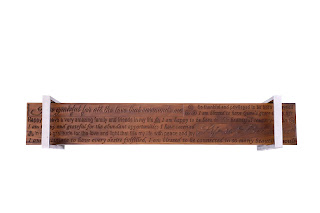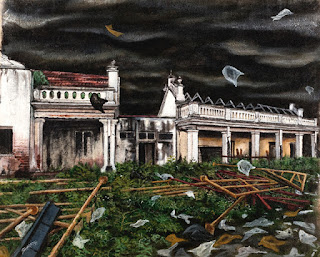A tribal art
demonstration was organized at Gallery Sumukha, Bangalore recently and it was a
delight to see Jangarh Singh Shyam’s family members (his wife, Nankusia Shyam) and their associates diligently
paint canvases and paper with Gond art.
Bright acrylic colours and meticulous detailing filled every inch of the
space inside the outlined figures!
Jangarh Singh Shyam – his Kalam
The Gond tribe is one
of the largest Adivasi communities in India and they inhabited the dense
forests of the Vindhyas, Satpura and Mandla in the Narmada region in Madhya
Pradesh*. As is common with most tribal
communities who express their joys and sorrows collectively and in a
ritualistic manner, the Gonds too have been celebrating their festivals and
rituals with songs and dances. For centuries they have been rooted in their
cultural practice and traditions. However,
in the 1980s many men from villages began to leave for the cities in search of
work. In those circumstances, Jagdeesh
Swaminathan, who was the Director of Bharat Bhawan in Bhopal and was
constructing the tribal art wing at Bharat Bhawan found Jangarh Singh Shyam who became
the first Gond artist to use paper and canvas for his art. As most of us know, Jangarh Singh Shyam’s tribal art found great support and
success and was exhibited widely not only in India but also abroad. When in Japan for a three month visit, while
he was still in his thirties Jangarh Singh Shyam took his life, under circumstances which are still not
clear. When I met Nankusia Shyam, the
late Jangarh Singh Shyam’s
wife, one could see that she still carried the burden of the pain and loss.

Nankusia Shyam creates her own identity
 Nankusia Shyam revealed that she had no interest in art initially, but
later on at the insistence of her husband she began to fill in colours in the
figures and drawings. Once Jangarh Singh
Shyam passed away, for her, painting was a way to continue his legacy as well
as a means of survival. During this
phase, many artists tried to take advantage of the situation and promote
themselves as Jangarh Singh Shyam’s heirs in the art world.
That forced Nankusia Shyam to come out of her mourning and establish
herself and her family as the legitimate practitioners of Gond art – or rather
the form which was initiated by Jangarh Singh Shyam. She gained confidence as
she worked more and often found herself working late in the night to complete
images for paintings which had to be delivered.
Incidentally, when Jangarh Singh Shyam was alive he already had a system in place where members of his
community were apprenticing with him while painting and assisting him. As a result, there is a whole community of
Gond artists who are practicing this tribal art form and are exhibiting in art
galleries in India and sometimes even abroad. The particular style and genre of
Gond painting which was initiated by Jangarh Singh Shyam is termed Jangarh Kalam. Bhuri
Bai and Lado Bai who were also present at the demonstration in Bangalore have
been associated with Nankusia Shyam for a long time.
Nankusia Shyam revealed that she had no interest in art initially, but
later on at the insistence of her husband she began to fill in colours in the
figures and drawings. Once Jangarh Singh
Shyam passed away, for her, painting was a way to continue his legacy as well
as a means of survival. During this
phase, many artists tried to take advantage of the situation and promote
themselves as Jangarh Singh Shyam’s heirs in the art world.
That forced Nankusia Shyam to come out of her mourning and establish
herself and her family as the legitimate practitioners of Gond art – or rather
the form which was initiated by Jangarh Singh Shyam. She gained confidence as
she worked more and often found herself working late in the night to complete
images for paintings which had to be delivered.
Incidentally, when Jangarh Singh Shyam was alive he already had a system in place where members of his
community were apprenticing with him while painting and assisting him. As a result, there is a whole community of
Gond artists who are practicing this tribal art form and are exhibiting in art
galleries in India and sometimes even abroad. The particular style and genre of
Gond painting which was initiated by Jangarh Singh Shyam is termed Jangarh Kalam. Bhuri
Bai and Lado Bai who were also present at the demonstration in Bangalore have
been associated with Nankusia Shyam for a long time.


Coming back to Nankusia Shyam, she has clearly come a long way. If you compare her early works to the recent
ones, there is a greater clarity and confidence in the paintings now. Images are refined and there is finesse in her
works. Mythical animals, fables and
other stories along with elements from nature are reflected in her
paintings. Her two older children, son Mayank
and daughter Japani are also accomplished artists as they have been painting
for many years. I came across one of
Japani’s paintings which was a delightful black and white work, with a
fascinating imagery and contextually much more contemporary in nature. Nankusia
Shyam’s youngest son has not shown much interest in painting until now, but she
is optimistic that he may take it up soon!
Folk and Tribal Art – Survival?
Gond art in its current form has been able to establish itself in the
mainstream galleries and has also been part of curated exhibitions. And, although there is a lot of competition
amongst the Gond artists to find recognition and acceptance in galleries and
auctions, I feel it has fared much better than other folk and tribal arts,
which are rendered as crafts displayed in handicraft and lifestyle stores.
No doubt, commercial and business aspects have crept into the
Gond art practice as well, but then one must accept that at the end of the day
it is a question of survival. As I have
said many times before, what is much needed at this juncture is sufficient
government and corporate support to ensure that our folk and tribal art and
other cultural practices/traditions can be sustained and conserved.
*http://ignca.nic.in/tribal_art_intro_gonds_mp.htm


















